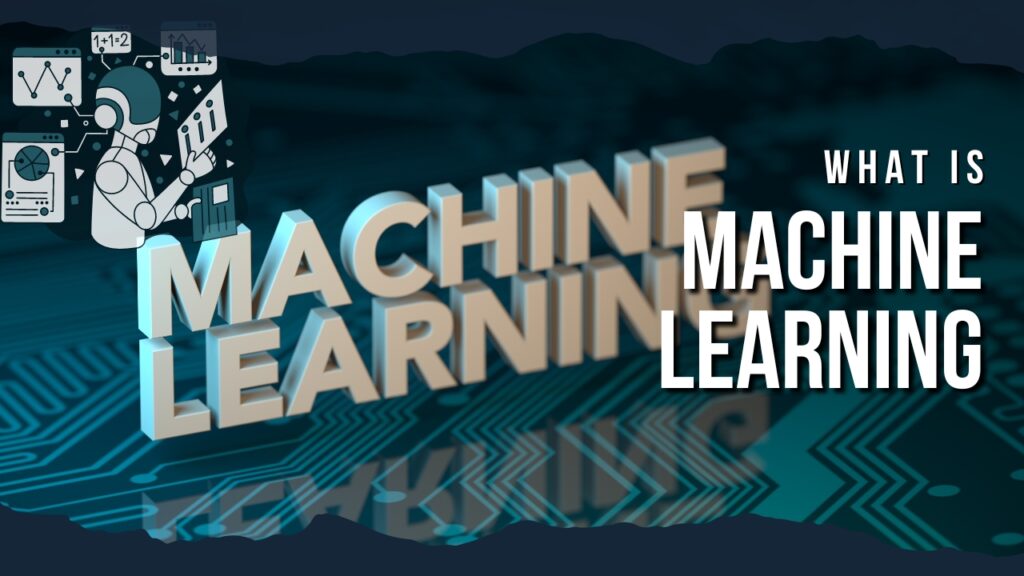Welcome to the extraordinary realm of machine learning! Here, the seemingly complex and mystical concepts of computers learning and making decisions on their own become simple, engaging, and wildly captivating.

Table of Contents
What Does Machine Learning Mean?
Machine learning (ML), in its most basic form, is about teaching computers to learn from data so they can make decisions or predictions on their own. No, we’re not talking about giving computers a course on calculus or Greek mythology! The ‘learning’ here revolves around recognizing patterns and making informed guesses.
Ever wondered how Netflix always knows what show you’ll binge-watch next or how Gmail filters spam from your inbox so accurately? Yep, that’s machine learning in action. From streaming platforms to self-driving cars, ML is working behind the scenes, improving your experiences and sometimes even saving lives!
By feeding computers a ton of data (and we mean a lot of it), they can figure out the patterns and correlations within the data. Over time, they get better and better at this, continually refining their predictions. It’s like the computer is that friend who always guesses the plot twists in movies, except that they get it right, like, 99% of the time.
Machine learning is a subset of artificial intelligence (AI). While AI is a broader concept of machines being able to carry out tasks in a smart way, ML is the actual implementation of this concept. It’s the part of AI that delivers the learning aspect. You could say that ML is the powerhouse that gives AI its brainpower.
The Main Types of Machine Learning
Machine learning is not a one-size-fits-all discipline; it’s rich and varied with diverse approaches that serve different goals. In this exciting playground, four main types stand out: supervised learning, unsupervised learning, semi-supervised learning, and reinforcement learning. They may sound a bit like jargon, but we promise to guide you through these with some simple, easy-to-understand analogies. Ready? Let’s jump right in.
Supervised Learning: The Taskmaster Approach
In supervised learning, we’re playing the role of a strict teacher overseeing diligent students.
Here’s how it works: we provide the machine (our student) with a dataset containing inputs and their corresponding correct outputs. This data is ‘labeled,’ meaning each example in the dataset is paired with a clear, correct answer.
The goal of supervised learning is for the machine to learn a general rule or pattern that links the inputs to the correct outputs. After the model is trained with this labeled data, it should be able to take a new, unseen input and predict the correct output.
If it can do that, it passes the test! Think of it like teaching a child arithmetic. Once they understand the rule that 2+2 equals 4, they can apply that rule to solve 3+3 or 5+5.
Unsupervised Learning: The Explorer’s Journey
Unsupervised learning is a different ball game. Imagine a bunch of kids let loose in a playground with the freedom to explore.
There are no strict rules or correct answers provided; the kids (or in our case, the machine) must figure out the lay of the land on their own.
Here, we give the machine a set of inputs, but we don’t give it any correct outputs or labels. Instead, the machine’s task is to find patterns, groupings, or structures in this unlabeled data.
It might discover that certain inputs are similar and group them together (a process called clustering). Or it might detect a hidden structure underlying the data.
This method is a great way to uncover hidden gems in large, complex datasets.
Semi-Supervised Learning: A Blend of Guidance and Freedom
As you might guess from the name, semi-supervised learning sits comfortably between supervised and unsupervised learning.
We give the machine some labeled data (like in supervised learning) and some unlabeled data (like in unsupervised learning).
This approach is useful when we have a lot of data but only a small portion of it is labeled. The machine uses the labeled data to learn a general rule and then applies this rule to make sense of the unlabeled data.
It’s like a guided exploration, where the machine is given a nudge in the right direction but also has the freedom to make its own discoveries.
Reinforcement Learning: The Game Player
In reinforcement learning, the machine isn’t just a student or an explorer—it’s a player in a game. The machine (or ‘agent’ in reinforcement learning parlance) learns by interacting with its environment. It makes decisions, takes actions, and gets rewards or penalties in return.
The goal of the machine is to figure out a strategy or ‘policy’ that will get it the most rewards over time. Imagine teaching a dog a new trick: if the dog performs the trick correctly, it gets a treat (a reward).
If not, it gets a stern look (a penalty). Over time, the dog learns to perform the trick correctly to get more treats. Similarly, a reinforcement learning agent learns to make the right decisions to rack up rewards.
Common Machine Learning Algorithms
Machine learning algorithms, the heart of the magic, are the methods used by systems to learn from data and improve over time. There are a bunch of them, each with its own strengths, weaknesses, and areas of application. Let’s get to know a few of the big players.
Neural Networks
Neural networks mimic the way our brain functions. Picture a vast network of interconnected processing points (our neurons) working in unison.
Neural networks shine when it comes to recognizing patterns and are the key players behind applications such as natural language translation, image recognition, speech recognition, and even image creation.
Just imagine, these guys are responsible for your phone recognizing your “Hey Siri” command. Isn’t that cool?
Linear Regression
Next up, we have linear regression. This algorithm is like the soothsayer of numerical values. Based on the linear relationship between different variables, it makes predictions.
For instance, this technique could predict the price of a house based on historical data about the area’s property values.
Logistic Regression
While it might sound similar to linear regression, logistic regression serves a different purpose. This algorithm is a whiz at making predictions for categorical responses—think binary outcomes like “yes” or “no”.
It’s extremely handy for applications such as classifying an email as spam or not, or monitoring quality control on a production line.
Clustering
Venturing into the realm of unsupervised learning, we meet clustering algorithms. These exploratory tools can identify hidden patterns in data and group them accordingly. By spotting differences and similarities that may not be evident to the human eye, they offer valuable insights into data sets.
So if you’re a data scientist looking for some hidden gems in your data, clustering algorithms are your best friends.
Decision Trees
Decision trees, as the name suggests, make decisions—they’re like flowcharts on steroids. These algorithms can be used for predicting numerical values (regression) and classifying data into categories (classification).
They follow a sequence of decisions, each branching out like a tree. One of the big pros of decision trees is their transparency—you can easily understand and validate how they arrived at a decision, unlike the ‘black box’ of neural networks.
Random Forests
Last, but certainly not least, we have random forests. These are a collection of decision trees that band together to make a prediction.
Each tree in the forest gives its own prediction, and the final output is determined by majority voting.
By combining the wisdom of multiple decision trees, random forests often achieve higher accuracy and avoid the overfitting problem common in single decision trees.
Machine Learning Applications
Now that we’ve gotten the basics out of the way, let’s dive into some real-world applications of machine learning. Spoiler alert: they’re likely closer to your everyday life than you think.
Machine Learning in our Digital Lives
In the realm of our digital interactions, machine learning is like a silent ninja, operating seamlessly in the background. It’s a significant player, enhancing our digital experiences with nuanced personalization and predictive capabilities.
Take a look at your email, for instance. Notice how spam messages get automatically filtered out, leaving your inbox clean and focused? That’s machine learning, trained to identify patterns in spammy content, working to save your day.
Or think about those uncannily accurate product recommendations you get on Amazon, which make you wonder if the internet can read your mind. Yep, you’ve got machine learning algorithms to thank (or blame) for that!
How about the way Siri, Alexa, or Google Assistant seems to understand your commands or even your jokes? It’s machine learning again, using techniques like Natural Language Processing (NLP) to understand and respond to human language. And let’s not forget those Netflix recommendations that seem to know your taste in movies and TV shows better than you do. That’s right, it’s machine learning stealing the show.
Machine Learning in Healthcare
Beyond our screens, machine learning is making remarkable strides in the field of healthcare. By crunching vast amounts of data, algorithms can predict disease outbreaks, helping authorities take timely preventive measures.
They can analyze medical images, such as MRIs or X-rays, to assist doctors in diagnosing diseases early and accurately.
Machine learning is also helping personalize medical treatments. By analyzing a patient’s genetic information, ML algorithms can predict how the patient might respond to different medications.
This can guide doctors in prescribing the most effective treatment, making healthcare more personalized and efficient.
Machine Learning in Finance
In the financial world, machine learning is a game-changer. It’s helping banks and credit card companies detect fraudulent transactions almost instantaneously.
How? By learning to recognize patterns that are typical of fraudulent activities. This means you can get an alert (or even have your card blocked) within moments of a suspicious transaction occurring.
Machine learning algorithms can also analyze past market trends and make predictions about future price movements. This can aid investors in making informed decisions and potentially earn them a fortune!
Machine Learning in Transportation
Machine learning is at the heart of autonomous vehicles, enabling them to learn from vast amounts of data collected from various sensors.
These vehicles can recognize traffic signs, detect obstacles, and make decisions, all thanks to machine learning.
ML is also optimizing logistics. It’s enabling companies to predict delivery times more accurately, optimize routes, and reduce fuel consumption.
In other words, machine learning is making transportation more efficient, reliable, and environmentally friendly.
Machine Learning vs. Deep Learning vs. Neural Networks
Each of these concepts plays a crucial role in the field of artificial intelligence, and understanding how they relate to each other will give you a clearer picture of this fascinating domain.
Think of machine learning, neural networks, and deep learning as nested dolls. Machine learning is the largest doll, encompassing the whole family. Neural networks are a smaller doll nestled within machine learning, and deep learning is an even smaller doll tucked inside neural networks.
| Concept | Definition | Example/Function |
|---|---|---|
| Machine Learning | A subset of AI that allows machines to learn from data without being explicitly programmed. | Supervised learning (like teaching a child arithmetic), unsupervised learning (letting kids loose in a playground), semi-supervised learning (a blend of guidance and freedom), reinforcement learning (learning like a player in a game). |
| Neural Networks | A type of machine learning model designed to mimic the human brain’s structure. | Can be used for image recognition, speech recognition, and natural language processing tasks. |
| Deep Learning | A subset of machine learning focusing on neural networks with many layers. | Used for tasks involving unstructured data, such as images, audio, or text. |
Machine Learning: The Big Umbrella
As we’ve already discussed, machine learning is a subset of AI that enables machines to learn from data. It’s like teaching machines to make predictions or decisions without being explicitly programmed to do so.
Remember the strict school teacher (supervised learning), the kids let loose in the playground (unsupervised learning), and the game player (reinforcement learning)?
These are all methods that fall under the big umbrella of machine learning.
Neural Networks: A Slice of the Machine Learning Pie
Neural networks are a particular type of machine learning model. They’re designed to mimic the human brain’s architecture—specifically, how our neurons connect and transmit signals.
Imagine a neural network as a complex web of nodes (neurons) and connections. The nodes are organized into layers: an input layer (where the data goes in), an output layer (where the predictions come out), and one or more hidden layers in between.
Each node takes in a set of inputs, does some computation, and passes the result to the next layer. It’s like a relay race, where the baton (the data) is passed from one runner (node) to the next.
Neural networks are a versatile tool in the machine learning toolbox. They can learn complex patterns and make accurate predictions, making them useful for tasks like image recognition, speech recognition, and natural language processing.
Deep Learning: Delving Deeper into Neural Networks
Deep learning is a subset of machine learning that focuses specifically on neural networks—with a twist. The “deep” in deep learning refers to the depth of the neural network, i.e., the number of hidden layers.
While a traditional neural network might have one or two hidden layers, a deep learning model has many (think dozens or even hundreds).
Why does depth matter? Well, the more layers a network has, the more complex the patterns it can learn.
A deep learning model can automatically learn to extract features from raw data, starting with simple features in the early layers and progressing to more complex ones in the later layers. This makes deep learning a powerhouse for tasks that involve unstructured data, such as images, audio, or text.
The Future of Machine Learning
Machine learning is an exciting and fast-paced field that’s continually evolving. As we collect more data and develop better algorithms, the potential of ML will only increase. It’s likely that in the future, we’ll see even more aspects of our lives touched by machine learning, from smarter homes to more personalized education.
But as we move forward, it’s essential to remember the ethical considerations as well. Issues like privacy, fairness, and transparency need to be addressed to ensure that the benefits of machine learning are enjoyed by all, without infringing on our rights or perpetuating harmful biases.




